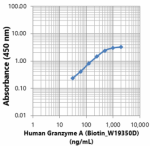- Clone
- W19350D (See other available formats)
- Regulatory Status
- RUO
- Other Names
- Hanukah factor serine protease (HFSP), Cytolytic T cell-and natural killer cellspecific trypsin-like serine protease, Cytotoxic T-lymphocyte-associated serineesterase 3 (CTLA3)
- Isotype
- Mouse IgG2b, κ
- Ave. Rating
- Submit a Review
- Product Citations
- publications

-

Direct ELISA showing biotin anti-human Granzyme A (clone W19350D) bound to plate-immobilized recombinant human Granzyme A protein (Cat. Nos. 550802 and 550804). The wells were incubated with serially diluted biotin primary antibody at room temperature for 2 hours in 1% BSA-PBS, followed by incubation with HRP goat anti-mouse IgG (Cat. No. 405306). TMB substrate (Cat. No. 421501) was used for detection. Absorbance was measured at 450 nm.
| Cat # | Size | Price | Quantity Check Availability | Save | ||
|---|---|---|---|---|---|---|
| 617253 | 50 µg | 265 CHF | ||||
Granzyme A is a serine protease belonging to the granzyme family and is expressed exclusively by cytotoxic T cells (CTL) and NK cells. Most circulating CD56+CD8- NK cells, and approximately half of circulating CD8+ T cells, coexpress both granzymes A and B. In contrast, few circulating CD4+ T cells express granzyme A or B. Activation of CD8+ and CD4+ T lymphocytes induces substantial expression of granzyme B, but not granzyme A. Following receptor-mediated conjugate formation between a granzyme-containing cell and an infected or transformed target cell, granzymes enter the target cell via endocytosis and induce apoptosis. Granzyme A was found to induce caspase-independent cell death when it enters into the target cell by perforin. Once in a cell, granzyme A activates DNA nicking by DNAse NM23-H1, a tumor suppressor gene product whose expression is reduced in transformed, metastatic cells. Dysregulation of this pathway results in several human diseases, such as hemophagocytic lymphohistiocytosis. Besides the protease activity, granzyme A induces human lung fibroblasts to produce IL-6 and IL-8. Cytokine induction is abrogated by treating the serine protease with the suicide serine protease inhibitor 3,4-dichloroisocoumarin. Other fibroblast lines, as well as epithelial cells, produce cytokines in response to granzyme A. These findings suggest that granzyme A can function as an activation molecule with potentially important immunoregulatory functions. However, CTLs from mice lacking granzyme A induce morphologically normal apoptosis in vitro, but those from mice that are deficient of granzyme B induce the nuclear features of apoptosis (particularly DNA fragmentation) more slowly than do wild-type CTLs.
Product DetailsProduct Details
- Verified Reactivity
- Human
- Antibody Type
- Monoclonal
- Host Species
- Mouse
- Immunogen
- Human Recombinant Granzyme A Protein
- Formulation
- Phosphate-buffered solution, pH 7.2, containing 0.09% sodium azide
- Preparation
- The antibody was purified by affinity chromatography and conjugated with biotin under optimal conditions.
- Concentration
- 0.5 mg/mL
- Storage & Handling
- The antibody solution should be stored undiluted between 2°C and 8°C. Do not freeze.
- Application
-
Direct ELISA - Quality tested
- Recommended Usage
-
Each lot of this antibody is quality control tested by Direct ELISA. The optimal concentration of this reagent for the specific application and the experiment design should be established by the end-user
- Additional Product Notes
-
This product is intended for sandwich-based immunoassay development on various assay platforms requiring antibody pairs. This antibody (clone W19350D) could function as a detection antibody when paired with purified anti-human Granzyme A antibody (Cat. No. 617152) (clone W19350A) as the capture antibody and using Recombinant Human Granzyme A protein (Cat. Nos. 550802 and 550804) as the assay standard.
- RRID
-
AB_3083218 (BioLegend Cat. No. 617253)
Antigen Details
- Structure
- Monomer
- Distribution
-
CTL and NK cells
- Function
- Granzyme A is able to induce target cell apoptosis by activating caspase independent pathways.
- Interaction
- Targets of CTL and NK cells.
- Cell Type
- Tregs
- Biology Area
- Cell Biology, Immunology, Innate Immunity, Neuroscience
- Molecular Family
- Enzymes and Regulators, Proteases
- Antigen References
-
- Edwards KM, et al. 1999. J Biol Chem. 274:30468-73.
- Lieberman J and Fan Z. 2003. Curr Opin Immunol. 15:553-9.
- Fan Z, et al. 2003. Cell. 112:659-72.
- Sower LE, et al. 1996. Cell Immunol. 171:159-63.
- Grossman WJ. et al. 2004. Blood. 104:2840-8.
- Ebnet K, et al. 1995. EMBO J. 14:4230-9.
- Heusel JW, et al. 1994. Cell. 76:977-87.
- Gene ID
- 3001 View all products for this Gene ID
- UniProt
- View information about Granzyme A on UniProt.org
Related FAQs
- How many biotin molecules are per antibody structure?
- We don't routinely measure the number of biotins with our antibody products but the number of biotin molecules range from 3-6 molecules per antibody.
Other Formats
View All Granzyme A Reagents Request Custom Conjugation| Description | Clone | Applications |
|---|---|---|
| Purified anti-human Granzyme A | W19350D | Direct ELISA |
| Biotin anti-human Granzyme A | W19350D | Direct ELISA |
Compare Data Across All Formats
This data display is provided for general comparisons between formats.
Your actual data may vary due to variations in samples, target cells, instruments and their settings, staining conditions, and other factors.
If you need assistance with selecting the best format contact our expert technical support team.
-
Purified anti-human Granzyme A

Direct ELISA showing purified anti-human Granzyme A (clone W... -
Biotin anti-human Granzyme A

Direct ELISA showing biotin anti-human Granzyme A (clone W19...
 Login / Register
Login / Register 









Follow Us